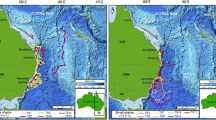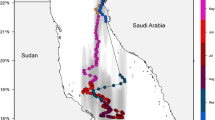Abstract
Satellite telemetry was used to study the movements and behaviour of ten blue sharks and one individual each of shortfin mako, thresher and bigeye thresher off eastern Australia. The tracks showed latitudinal movements of up to 1,900 km, but none of the sharks travelled away from the eastern Australian region. Tracking periods did not exceed 177 days. All species showed oscillatory dive behaviour between the surface layers to as deep as 560–1,000 m. Blue sharks spent 35–58% of their time in <50 m depths and 10–16% of their time in >300 m. Of these four species, the bigeye thresher spent the least time in the surface layers and the most time at >300 m depth. All four species showed clear diel behaviour generally occupying shallower depths at night than during the day. Blue sharks were mainly in 17.5–20.0°C water, while the thresher sharks showed a more bimodal temperature distribution.













Similar content being viewed by others
References
ARGOS (2008) Argos user’s manual. http://www.argos-system.org/manual/
Bonfil R (1994) Overview of world elasmobranch fisheries. FAO Fisheries Technical Paper (341). FAO, Rome, 119 pp
Bruce BD, Bradford RW (2008) Spatial dynamics and habitat preferences of juvenile white sharks—identifying critical habitat and options for monitoring recruitment. Final report to Department of Environment, Water, Heritage and the Arts, 71 pp
Bruce BD, Stevens JD, Malcolm H (2006) Movements and swimming behaviour of white sharks (Carcharodon carcharias) in Australian waters. Mar Biol 150:161–172
Campana SE, Joyce W, Manning MJ (2009) Bycatch and discard mortality in commercially caught blue sharks Prionace glauca assessed using archival satellite pop-up tags. Mar Ecol Prog Ser 387:241–253
Carey FG, Scharold JV (1990) Movements of blue sharks (Prionace glauca) in depth and course. Mar Biol 106:329–342
Chapman DD, Pikitch EK, Babcock EA, Shivji MS (2007) Deep-diving and diel changes in vertical habitat use by Caribbean reef sharks Carcharhinus perezi. Mar Ecol Prog Ser 344:271–275
Clarke SC, Magnussen JE, Abercrombie DL, Mcallister MK, Shivji MS (2006a) Identification of shark species composition and proportion in the Hong Kong shark fin market based on molecular genetics and trade records. Cons Biol 20(1):201–211
Clarke SC, Mcallister MK, Milner-Gulland EJ, Kirkwood GP, Michielsens CGJ, Agnew DJ, Pikitch EK, Nakano H, Shivji MS (2006b) Global estimates of shark catches using trade records from commercial markets. Ecol Lett 9:115–1126
Compagno LJV (1984) FAO species catalogue, vol 4. Sharks of the world: an annotated and illustrated catalogue of shark species known to date. Part 2. carcharhiniformes. FAO Fisheries Synopsis (125) FAO, Rome, pp 251–655
Cox G, Francis M (1997) Sharks and rays of New Zealand. Canterbury University Press, Christchurch, p 68
Domeier ML, Nasby-Lucas N (2008) Migration patterns of white sharks Carcharodon carcharias tagged at Guadalupe Island, Mexico, and identification of an eastern Pacific shared offshore foraging area. Mar Ecol Prog Ser 370:221–237
Dulvy NK, Baum JK, Clarke S, Compagno LJV, Cortés E, Domingo A, Fordham S, Fowler S, Francis MP, Gibson C, Martínez J, Musick JA, Soldo A, Stevens JD, Valenti S (2008) You can swim but you can’t hide: the global status and conservation of oceanic pelagic sharks and rays. Aquatic Conserv Mar Freshw Ecosyst 18:459–482
Graham RT, Roberts CM, Smart JCR (2006) Diving behaviour of whale sharks in relation to a predictable food pulse. J R Soc Interf 3:109–116
Hays GC, Bradshaw CJA, James MC, Lovell P, Sims DW (2007) Why do Argos satellite tags deployed on marine animals stop transmitting? J Exp Mar Biol Ecol 349:52–60
Heithaus MR, Wirsing AJ, Dill LM, Heithaus LI (2007) Long-term movements of tiger sharks satellite-tagged in Shark Bay, Western Australia. Mar Biol 151:1455–1461
Holts DB, Bedford DW (1993) Horizontal and vertical movements of the shortfin mako shark, Isurus oxyrinchus, in the southern California Bight. Aust J Mar Freshw Res 44:901–909
Klimley AP, Beavers SC, Curtis TH, Jorgensen SJ (2002) Movements and swimming behavior of three species of sharks in La Jolla Canyon, California. Env Biol Fish 63:117–135
Kohler NE, Turner PA (2008) Stock structure of the blue shark, Prionace glauca, in the North Atlantic Ocean based on tagging data. In: Camhi MD, Pikitch EK (eds) Sharks of the open ocean: biology, fisheries and conservation. Blackwell, Oxford, pp 339–350
Kohler NE, Casey JG, Turner PA (1998) NMFS Cooperative shark tagging program, 1962–93: an atlas of shark tag and recapture data. Mar Fish Rev 60(2):1–87
Last PR, Stevens JD (2009) Sharks and rays of Australia. CSIRO, Australia, p 644
Laurs MR, Foley, DG, Musyl M (2008) Identification of large pelagic shark habitats in the central North Pacific using PSATs, satellite remote sensing, and SODA assimilation ocean models. Pelagic Fisheries Research Program/PI meeting Honolulu, Hawaii Nov18–19 2008. http://www.soest.hawaii.edu/PFRP/nov08mtg/nov08mtg_presentations.html
Moyes CD, Fragoso N, Musyl MK, Brill RW (2006) Predicting post-release survival in large pelagic fish. Trans Am Fish Soc 135:1389–1397
Nakano H, Seki MP (2003) Synopsis of biological data on the blue shark, Prionace glauca Linnaeus. Bull Fish Res Agen No 6:18–55
Nakano H, Stevens JD (2008) The biology and ecology of the blue shark, Prionace glauca. In: Camhi MD, Pikitch EK (eds) Sharks of the open ocean: biology, fisheries and conservation. Blackwell, Oxford, pp 140–151
Nakano H, Watanabe Y (1992) Effect of high seas driftnet fisheries on blue shark stock in the North Pacific. In: Compendium of documents submitted to the scientific review of North Pacific high seas driftnet fisheries, vol 1. Sidney, BC, Canada, 11–14 June 1991, 15 pp
Nakano H, Matsunaga H, Okamoto H, Okazaki M (2003) Acoustic tracking of bigeye thresher shark Alopias superciliosus in the eastern Pacific Ocean. Mar Ecol Prog Ser 265:255–261
Pade NG, Queiroz N, Humphries NE, Witt MJ, Jones CS, Noble LR, Sims DW (2009) First results from satellite-linked archival tagging of porbeagle shark, Lamna nasus: area fidelity, wider-scale movements and plasticity in diel depth changes. J Exp Mar Biol Ecol 370:64–74
Patterson TA, Evans K, Carter TI, Gunn JS (2008) Movement and behaviour of large southern bluefin tuna (Thunnus maccoyii) in the Australian region determined using pop-up satellite archival tags. Fish Oceanog 17:352–367
Sciarrotta TC, Nelson DR (1977) Diel behaviour of the blue shark, Prionace glauca, near Santa Catalina Island, California. Fish Bull 75(3):519–528
Sepulveda CA, Kohin S, Chan C, Vetter R, Graham JB (2004) Movement patterns, depth preferences, and stomach temperatures of free-swimming juvenile mako sharks, Isurus oxyrinchus, in the Southern California Bight. Mar Biol 145:191–199
Shepard ELC, Ahmed MZ, Southall EJ, Witt MJ, Metcalfe JD, Sims DW (2006) Diel and tidal rhythms in diving behaviour of pelagic sharks identified by signal processing of archival tagging data. Mar Ecol Prog Ser 328:205–213
Sims DW, Southall EJ, Richardson AJ, Reid PC, Metcalfe JD (2003) Seasonal movements and behaviour of basking sharks from archival tagging: no evidence of winter hibernation. Mar Ecol Prog Ser 248:187–196
Sims DW, Southall EJ, Tarling GA, Metcalfe JD (2005) Habitat-specific normal and reverse diel vertical migration in the plankton-feeding basking shark. J Anim Ecol 74:755–761
Stevens JD (1976) First results of shark tagging in the north-east Atlantic. J Mar Biol Assoc UK 56:929–937
Stevens JD (1990) Further results from a tagging study of pelagic sharks in the north-east Atlantic. J Mar Biol Assoc UK 70:707–720
Stevens JD (2000) The population status of highly migratory oceanic sharks. In: Hinman K (ed) Getting ahead of the curve: conserving the Pacific ocean’s Tunas, Swordfish, Billfishes and Sharks. Marine fisheries symposium no. 16. National Coalition for Marine Conservation, Leesburg, VA
Teo SLH, Boustany A, Blackwell S, Walli A, Weng KC, Block BA (2004) Validation of geolocation estimates based on light level and sea surface temperature from electronic tags. Mar Ecol Prog Ser 283:81–98
Weng KC, Block BA (2004) Diel vertical migration of the bigeye thresher shark (Alopias superciliosus), a species possessing orbital retia mirabilia. Fish Bull 102:221–229
Weng KC, Castilho PC, Morrissette JM, Landeira-Fernandez AM, Holts DB, Schallert RJ, Goldman KJ, Block BA (2005) Satellite tagging and cardiac physiology reveal niche expansion in salmon sharks. Science 310(5745):104–106
Weng KC, Boustany AM, Pyle P, Anderson SD, Brown A, Block BA (2007a) Migration and habitat of white sharks (Carcharodon carcharias) in the eastern Pacific Ocean. Mar Biol 152:877–894
Weng KC, O’Sullivan JB, Lowe CG, Winkler CE, Dewar H, Block BA (2007b) Movements, behavior and habitat preferences of juvenile white sharks Carcharodon carcharias in the eastern Pacific. Mar Ecol Prog Ser 338:211–224
Weng KC, Foley DG, Ganong JE, Perle C, Shillinger GL, Block BA (2008) Migration of an upper trophic level predator, the salmon shark Lamna ditropis, between distant ecoregions. Mar Ecol Prog Ser 372:253–264
West G, Stevens J, Basson M (2004) Assessment of Blue Shark population status in the Western South Pacific. AFMA project R01/1157. CSIRO Marine Research, Hobart, Tasmania, Australia, 139 pp
Wilson SG, Polovina JJ, Stewart BS, Meekan MG (2006) Movements of whale sharks (Rhincodon typus) tagged at Ningaloo Reef, Western Australia. Mar Biol 148:1157–1166
Acknowledgments
We thank John Gunn for obtaining funds to purchase satellite tags to help in our understanding of the ecosystem supporting the East Coast Tuna and Billfish Fishery, Thor Carter for his help in deploying tags from commercial longline vessels, Alistair Hobday for some suggestions on data presentation and Barry Bruce and Colin Simpfendorfer, together with two anonymous referees, for helpful and constructive comments on the manuscript. This work was supported by CSIRO Marine and Atmospheric Research and the Wealth from Oceans Flagship Programme.
Author information
Authors and Affiliations
Corresponding author
Additional information
Communicated by S. Garthe.
Rights and permissions
About this article
Cite this article
Stevens, J.D., Bradford, R.W. & West, G.J. Satellite tagging of blue sharks (Prionace glauca) and other pelagic sharks off eastern Australia: depth behaviour, temperature experience and movements. Mar Biol 157, 575–591 (2010). https://doi.org/10.1007/s00227-009-1343-6
Received:
Accepted:
Published:
Issue Date:
DOI: https://doi.org/10.1007/s00227-009-1343-6




